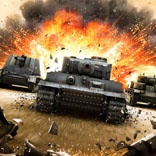Rolling Thunder: A Personal Look at World of Tanks
At first glance, World of Tanks might look like just another shooter, but under the surface, it's really a tactical battleground. Each tank class — light, medium, heavy, tank destroyers, and artillery — has its own playstyle, strengths, and weaknesses. Success doesn’t just come from quick reflexes, but from smart positioning, team coordination, and a deep understanding of each map's terrain.
The gameplay is a unique blend of pacing and tension, where knowledge, reaction, and timing all intertwine. You’re not just running and gunning—you’re anticipating your enemy’s moves, planning flanks, and setting up ambushes. You might hide behind a rock waiting for the perfect moment to strike or charge forward to draw enemy fire so a teammate can land a killing blow. Every decision matters. The tactical depth turns every match into a kind of high-stakes chess match — except with roaring engines and explosive shells.
The beauty of this system lies in its complexity. Light tanks are fast scouts, revealing enemy positions while evading return fire with speed and agility. Medium tanks are the jack-of-all-trades, capable of supporting pushes, flanking, or defending. Heavy tanks form the backbone of the frontlines, designed to soak up damage and lead the charge. Tank destroyers sit in the shadows, dealing devastating damage from a distance, while artillery rains down death from afar, demanding both patience and precision.
Some matches feel like lightning-fast skirmishes, while others become slow, nerve-wracking battles of attrition. The tension is tangible — especially when you find yourself as the last tank standing on your team, knowing your every movement could make or break the game. Few titles deliver this kind of intensity in short bursts.
Map knowledge is a cornerstone of mastery in World of Tanks. Knowing the high ground on "El Halluf" or the best ambush positions on "Prokhorovka" can drastically shift your chances of winning. Every map has quirks, chokepoints, hiding spots, and flanking routes that can be exploited by smart players. It’s not enough to know where to go — you need to know when and how to go there.
Even after hundreds of matches, I find myself learning new tricks and developing better instincts. For example, I began to recognize when to peek a corner to bait a shot and retreat, letting an ally push while the enemy reloads. Or how to angle my tank’s armor to increase the chance of bouncing incoming shells. These micro-decisions add up, separating casual players from experienced tank commanders.
The game's matchmaking and team dynamics also play a massive role. While you're often at the mercy of random teammates, good communication and awareness can tip the balance. Even without voice chat, a well-timed ping or a clever positioning play can coordinate an effective assault or defense.
World of Tanks constantly rewards player improvement. You’ll quickly learn that rushing blindly into enemy territory leads to quick deaths, while cautious, strategic play results in more survivability and higher impact. There’s also a profound sense of satisfaction in knowing that your carefully planned maneuver contributed to your team’s win, even if you didn’t get the most kills.
Newcomers might feel overwhelmed initially, but the learning curve is manageable. The game does a decent job of introducing core mechanics, and the community has produced a mountain of guides, tutorials, and walkthroughs to help players improve. Mastering the gameplay takes time, but each step feels worthwhile.
In summary, World of Tanks delivers an exceptional gameplay experience by blending strategy and action. Every shot, every move, every tank is a piece of a larger puzzle — one you get better at solving each time you roll out onto the battlefield.

World of Tanks is not just a game of battles; it’s a game of long-term commitment. The progression system is extensive, deep, and often, a reflection of your dedication. After hundreds of hours in the game, I’ve come to appreciate how this system is both a strength and, at times, a challenge.
The core of World of Tanks’ progression is the tech tree. Each nation has multiple branches representing different types of tanks: light, medium, heavy, tank destroyers, and artillery. As you gain experience (XP) from battles, you use it to research new modules and unlock the next tier of vehicles. This can be incredibly rewarding — reaching a Tier X tank after grinding through an entire line feels like a real achievement. It’s not just a vehicle; it’s a badge of honor.
The tech tree doesn’t just guide you in terms of new tanks. Each tank also has modules that can be upgraded — from better guns and engines to improved radios and suspension. Early on, a stock tank can feel weak or sluggish, but as you unlock its full potential, the difference is dramatic. It adds a sense of growth and encourages players to stick with a tank and master its nuances.
My personal favorite grind was through the Soviet heavy tank line. Starting from humble beginnings with the KV-1, I worked my way up to the mighty IS-7. That tank is a monster — excellent frontal armor, strong gun, and decent mobility for a heavy. Reaching it felt like the culmination of everything I’d learned and accomplished in the game. And despite now having dozens of tanks, the IS-7 remains my go-to for intense matches.
Customization is another pillar of the experience. You can tailor each tank to your playstyle using equipment (such as gun rammers, vents, and optics), consumables (repair kits, med kits), and crew skills. The crew system adds an RPG-like element. As your crew gains experience, they can learn perks and skills that enhance your tank’s performance — from faster reloads to better camouflage or situational awareness.
Cosmetic customization also allows you to personalize your ride. Historical skins, seasonal camouflages, decals, and emblems let you make your tank feel unique. Some of the premium skins are surprisingly artistic, and while they don’t offer any gameplay advantage, they certainly let you stand out.
Economically, the game operates on a multi-currency system: credits (earned from battles), experience (for research), gold (premium currency), and bonds. While you can play and progress entirely for free, there’s a definite incentive to spend money — whether for premium time (which increases earnings), premium tanks (often faster to grind and credit-rich), or cosmetic items.
The premium model in World of Tanks walks a delicate balance. It’s not pay-to-win in the traditional sense — skill still reigns supreme — but paying does make life easier. Premium tanks often have favorable matchmaking and great credit generation. However, free-to-play players can still reach the same heights; it just takes more time and effort.
Events and missions also help with progression. Special operations might reward blueprints (which reduce the XP cost for tank research), equipment, or even free vehicles. Wargaming does a decent job of rotating in fresh incentives, ensuring players have new goals to chase.
Another notable feature is the in-game economy’s attention to realism. Shell costs, repair bills, and maintenance can eat into your earnings if you’re not careful. Playing recklessly might lead to losses, not just in score, but in credits too. It makes you think twice before blindly charging into a fight, and encourages smart, sustainable gameplay.
Clan activities and ranked modes introduce another layer of progression. Clans can compete for territories on the Global Map, earning gold and other rewards. It’s a more strategic, organized form of gameplay that emphasizes coordination and high-level play. If you’re looking for competitive motivation beyond random battles, clans offer a strong endgame loop.
All these systems feed into a sense of ownership and identity. Your garage becomes a representation of your journey — the battles you’ve fought, the tanks you’ve mastered, and the challenges you’ve overcome. Each tank tells a story.
That said, not everything is perfect. Some players criticize the grind, particularly at higher tiers where matches become more expensive and slower to progress. And while the game tries to be fair, there’s still an ongoing debate about the balance between premium and free-to-play content. For new players, the economy can seem overwhelming at first, and mistakes (like spending credits inefficiently) can set you back.
Despite these issues, the depth of the progression and customization system is a major reason why World of Tanks stays engaging. There’s always something to unlock, improve, or achieve. It’s a long journey, but one that’s rich with reward for those willing to commit.

 100
Play
100
Play
World of Tanks excels in creating a distinct and immersive atmosphere that blends historical reverence with modern action. From the moment you load into a match, the game surrounds you with the roar of engines, the thunder of artillery, and a visual landscape that echoes real-life battlefields. Every tank feels heavy, dangerous, and grounded in authenticity. The visual design — from the textures of tank armor to the rubble-strewn cities — evokes a war documentary brought to life.
Sound plays a vital role too. The audio design in World of Tanks is often underappreciated, but it's part of what makes each shot fired or hit taken so visceral. The whine of treads, the metallic clang of ricocheting shells, and the earth-shaking roar of a direct hit all contribute to the immersion. The game doesn’t need a dramatic soundtrack to set the mood — it relies instead on the realism of its world.
What elevates this atmosphere further is the attention to historical detail. While not every tank is a perfect replica, Wargaming has clearly invested in crafting vehicles that look, sound, and behave believably. They even collaborate with military museums and use historical documentation to create accurate models. This makes the game not only entertaining but also educational to some degree.
The community that surrounds World of Tanks is a mixed but passionate one. Like many online games, you’ll encounter a wide range of players — from helpful veterans willing to coach new recruits, to the occasional troll who rages in chat. But overall, the player base is knowledgeable, invested, and often generous with tips and advice.
Forums and subreddits dedicated to WoT are filled with in-depth discussions, memes, guides, and updates. You’ll find debates about the best Tier VIII tank, detailed breakdowns of armor values, and even historical photos of the tanks that inspired the in-game models. This richness of engagement speaks to how deeply the game resonates with its fans.
Wargaming’s interaction with the community has had highs and lows. They’ve hosted global tournaments, special events, and even tank festivals to engage with their player base. However, some business decisions — like monetization models or sudden balance changes — have occasionally led to backlash. Still, the developers do listen, and many updates stem from community feedback.
Social features are somewhat basic, but functional. Platooning with friends works well, and joining a clan opens up new dimensions of play. Clans not only allow for teamwork in battles but also form the backbone of the game’s most competitive modes. It’s in these spaces that long-term bonds and rivalries form, contributing to a rich, ongoing narrative that lives beyond individual matches.
One of the most compelling aspects of the game is its long lifespan and regular updates. World of Tanks has been around for over a decade, and it’s still going strong thanks to constant tweaks, new vehicles, and seasonal content. The developers have managed to keep it fresh without fundamentally altering the core that makes the game so compelling.
For me, World of Tanks is more than a game — it's a passion project that rewards time, effort, and strategic thinking. It’s the kind of title you can lose yourself in for hours or play casually for a match or two. And every time you roll out, there’s a new story waiting to unfold.
Whether you’re a history buff, a strategy enthusiast, or someone who just loves the thrill of battle, World of Tanks has something to offer. It’s not without flaws, but its combination of engaging gameplay, deep progression, rich atmosphere, and a committed community make it one of the most satisfying multiplayer experiences available today.


